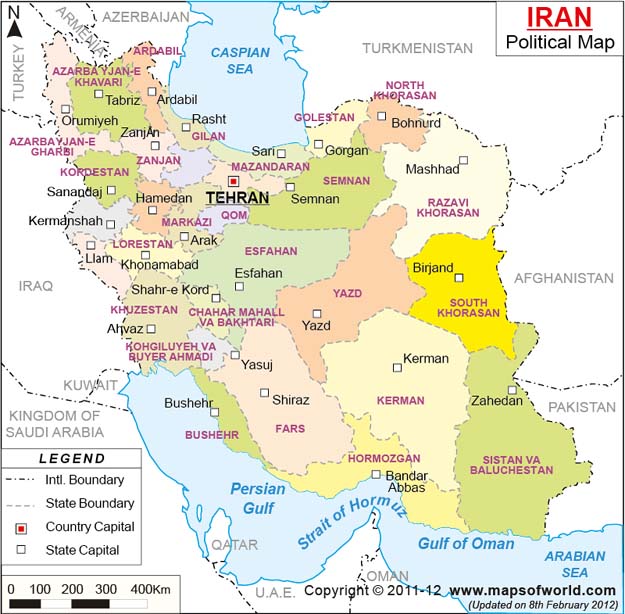About Iran
About Iran
Covering an area of 1,648,000 square kilometers, Iran is located in southwestern Asia. Total terrestrial borders of the country are 5,170 km. and total water borders are 2,510 km.
According to the latest divisions of the country, Iran is divided into 30 provinces.

Iran is Situated at the heart of the Middle East.
Unique landscapes such as limpid water springs, pomegranate orchards, pistachio gardens, decampment of nomads in different seasons, starry nights, rocky mountains, endless high and low lands, dense forests of the Alborz Mountain Range, and coastlines of the Caspian Sea, the Persian Gulf and the Sea of Oman are all eye-catching and memorable.
Iran's landscapes vary remarkably at different seasons. They are at times full of stone and sand, at times full of floodwater, sometimes covered by snow or by lush vegetation. Iranian artists have portrayed Iran's nature as a sign of diversity and charm in their different and diverse artistic works.
Among significant characteristics of the vast land of Iran is the existence of high mountains as well as flat plains, desert areas, rivers and lakes contributing to unique geographical conditions in which, at any time of the year, and in each section of the country, one of the four seasons is visible. Thus, in winter, swimming and water skiing are possible in the warm waters of the Persian Gulf, and at the same time winter sports, like skiing are possible in the northern and western mountains of the country, while one can enjoy the pleasant spring weather along the shores of the Caspian Sea- at the same time of the year.In fact Iran is a four-season country.
Complexity and diversity of geological and calcareous structures have contributeded to the formation of so many caves in different provinces, specially in Azarbayjan, Kurdestan, and Hamadan, which are attractive to numerous tourists. Visiting some of these caves is highly recommended and they are among important tourism attractions.
The two well-known deserts of Iran, Dasht-e-Loot and Dasht-e-Kavir, covering an area of over 360,000 square kilometers, are among the most interesting yet unknown places.
With more than 500 known mineral water and thermal springs used for different purposes, Iran has an important potential in this regard. Most of these springs attract many people all around the year for recreation and therapeutic purposes.
The coasts of the Caspian Sea, with pleasant sandy beaches, are among the most important tourist attractions in Iran. Moreover, the southern shores and islands of Iran have their own natural beauty and being used as tourism attractions specially in winter. The slopes of Alborz and Zagross Mountains with numerous springs, lakes and wetlands have their own beautiful and eye-catching landscapes.
Iran enjoys considerably variable climates
In January and February, there are three climatic zones in Iran. Shores of the Caspian Sea have mild and relatively cold weather, central parts have typical winter weather, and southern parts enjoy moderate and pleasant weather. Most regions of Iran enjoy pleasant weather in the spring, specially in April. However, the weather in southern regions of Iran grows very hot unexpectedly as early as March.Tourists, who visit the southern coasts of Iran in winter, can enjoy very pleasant weather; while at the same time the cities of Esfahan and Fars provinces are rainy and snowy. In general, in the summer, the weather in most parts of the country is warm but not intolerable. Spring and autumn are a suitable time for touring all around the country. Hotels are usually booked up during national holidays for Norooz (Iranian New Year starting March 21st).
More Information About Iran
Physical situation of the country
Formal Name: The Islamic Republic of Iran.
Short name: Iran.
Term for Citizens: Iranians.
Capital: Tehran.
Date of Establishment of the Islamic Republic of Iran: April 1st, 1979.
Area: 1,648,000 square kilometres.
Time: GMT+3.5
Climate: The climate is dry tropical with very hot summer and cold, with some snow, winter.
Population: 75.1 million people by 2011; growth rate is 1.3 % a year; population density is 46 persons per square kilometre; 71.4% of the population is urban and 28.6% is rural or migrating. Persian (51%), Azerbaijani (24%), Gilaki and Mazandarani (8%), Kurd (7%), Arab (3%), Lur (2%), Baluch (2%), Turkmen (2%), other (1%)
Language: Official language is Farsi. Persian and Persian dialects (58%), Turkic and Turkic dialects (26%), Kurdish (9%), Luri (2%), Baluch (1%), Arabic (1%), Turkish (1%)
Religion: Islam is the official religion; about 98.5% of population is Muslim (Shiite - 89%, Sunni - 9.5%); Iran also has minority groups of Zoroastrians, Jews, Armenians, Assyrians, Catholics and Protestants, all of which are respected.
Education: General education is free and compulsory from the age of six. It comprises 12 years. By 2000 literacy for all Iranians aged 15 and older had reached 76.9 %.
Major industries: Natural gas, oil, petroleum products, food processing, textile.
Major trading partners: Japan, South Korea, Italy, Germany, China, France, United Arab Emirates.
Money: Currency is called Iranian Rial (IRR).
Ecology: Air pollution, especially in urban areas, from vehicle emissions, refinery operations, and industrial effluents; deforestation; overgrazing; desertification; oil pollution in the Persian Gulf; inadequate supplies of potable water.
Health: Basic medical care and medicines are available in the principal cities of Iran.
Culture: Priceless archaeological finds; lots of historical monuments; traditional handicrafts and famous Iranian carpets.
Popular tourist destinations: Tehran, Mashhad, Susa, Persepolis, Isfahan, Hamadan, Shiraz, Yazd, Pasargadae, Kerman, Kermanshah, etc.
.....
.....
.....

.jpg)



























